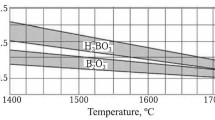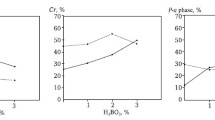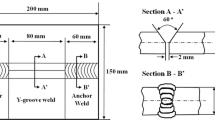The reliability of an industrial frequency crucible (IFC) induction furnace, used in casting manufacture, depends on its lining life. For this reason quartzite as the cheapest acid lining material is the subject of considerable research work both in our country and overseas. The aim of the present research is development of manufacturing technology and operation of an acid lining that is used for melting alloys and with melt operating temperatures above 1450°C. The action of melt thermal regimes on the change in interplanar distances within the quartzite structure affecting furnace lining life is studied.
Similar content being viewed by others
Avoid common mistakes on your manuscript.
Refractory materials and objects provide functioning of the main production units and machines of the majority of branches of industry. In many cases functioning and efficiency of production systems is due to the quality and operating properties of refractories. This primarily concerns ferrous and nonferrous metallurgy, power generation, the chemical industry, engineering, etc.
The basis of the majority of forms of refractory materials comprise the following refractory oxides: MgO (Tm 2800°C), CaO (2614°C), Cr2O3 (2299°C), Al2O3 (2050°C), SiO2 (1730°C), and ZrO2 (2700°C). Objects manufactured using these oxides are classified with respect to chemical composition into:
-
acid based on SiO2;
-
basic based on CaO and MgO;
-
neutral based on Al2O3 and Cr2O3.
With respect to special indications they are classified in the following forms:
-
natural origin and artificially prepared;
-
molded having a certain geometric shape and dimensions.
-
unmolded produced in the form of powder, used after mixing with other components in the form of mix prepared for use.
One of the largest groups of customers for acid refractory materials is the metallurgical branch in which they are used as a flux, and also as refractory acid-resistant material (dinas) and in the production of ferroalloys. In addition, unmolded refractories are produced from quartzite materials for lining induction furnaces, iron smelting, and steel pouring ladles.
An industrial frequency crucible (IFC) induction furnace, used in casting production, concerns the main production resource of an enterprise and is the main factor governing the strategy for enterprise development as a whole. An increase in furnace operating reliability is one of the main tasks of regenerating these resources. This provides universality during smelting of alloys, productivity, good refractory life, energy efficiency, and optimization of expenditure on services [1]. According to the certificate of an IFC furnace it is designed for melting alloys at a melting temperature not above 1450°C and uses in this case an acid lining, proving a good life. The basis of this lining is quartzite [2].

With a change-over from one quartz modification to another there is a significant change in volume that should be considered during development of production technology and refractory operating conditions:
Over the horizontal stable modifications are indicated, and over the vertical there is an indication of unstable modifications, the transformation temperature for one modification into another, and also the change in volume during transformations. Horizontal transformations proceed slowly and almost irreversibly, and transformations within the limits of one modification (vertical) proceed comparatively readily and are reversible. As is seen, at approximately 600°C all transformations proceed into metastable phases [3].
It is possible to assess the degree of transformation of quartzite into tridymite and cristobalite according to the density of fired objects made from dinas. The lower the density, the more complete is the transition. If a lining is made from weakly fired refractory, in which quartz is not converted into cristobalite or tridymite, then these transformations proceed in a lining during furnace warm-up. In this case the volume of refractory increases significantly and a lining may break. Dinas objects within which during firing a considerable part of the quartz is transformed into tridymite or cristobalite are called tridymitized or tridymite-cristobalite. Their composition contains 40 – 70% tridymite, 20 – 40% cristobalite, 5 – 15% quartz, and glassy substance 1 – 15% [4]. Tridymite-cristobalite dinas maintains mechanical strength and does not change shape almost up to the melting temperature. Therefore dinas objects are used extensively in metallurgy, especially where good mechanical strength at high temperature is required.
In 1934 N. K. Kaznalov detected that on heating a dinas object above 575°C there is transformation of β-quartz into α-quartz. During heating above 870°C tridymite should form, but this does not occur, and instead of this at 1200°C transformation is observed into cristobalite.With higher temperature firing cristobalite objects are transformed into tridymite [5]. This picture of transformations in dinas is observed in the case when dinas is prepared from slowly generated crystalline quartzite during firing.
In addition, the effect has been established of firing temperature and soaking duration on object microstructure. In the microstructure of dinas fired at 1350°C almost complete absence of tridymite is observed (dinas density 2.45 g/cm3), and within the dinas microstructure fired at 1450°C there is cracking of coarse quartzite particle and formation of a considerable amount of fine tridymite (dinas density 2.40 g/cm3). Amarked disadvantage of dinas is the low resistance with sharp changes in temperature (thermal shock resistance), and it only withstands 1 – 2 water thermal cycles. It has been established that repeated cyclic changes in temperature in a glass-making furnace with a lining of dinas objects affects the degree of quartzite transformation into tridymite and cristobalite, and correspondingly its life [6].
Similar processes should also be seen in quartzite, which is used for manufacturing an IFC lining, and affects its life [7]. Changes have been established [8] of the size of quartz crystal lattice, density of an elementary cell, and polymorphic transformations that occur under the following conditions:
-
during removal of moisture with use of different temperature regimes;
-
at a temperature corresponding to the end of the lining sintering process;
-
at temperatures corresponding to melt pouring and charging a new metal. However, the crystal lattice parameters that affect its change during action of melting temperature regimes also concern interplanar distance, which also affects the life of a lining itself [9]. It is represented by values of the short distance between adjacent identical atom (ion) planes in a crystal, and it as it were its testimonial (Fig. 1).
For this reason the aim of the present work is to study changes of interplanar distances in quartzite under action of temperature corresponding to synthetic cast iron melting production regimes in an IFC-10 furnace with melt operating temperatures above 1450°C (Fig. 2) [10]. Use of these temperatures is due to application in a melt of up to 90% steel scrap both in our country and overseas [11]. These regimes are maintained to complete production wear of a lining, and to the instant of its breakdown. Use of these melting temperatures leads to more intense occurrence of interaction of a lining with melt and significantly reduces its life [12]. A search for solutions making it possible to increase the operating life of a melting furnace is one of the tasks for improving production efficiency [13].
Research was conducted for quartzite grade PKMVI from the Pervoural Dinas Plant using a D8 ADVANCE diffractometer from Bruker. Diffraction patterns were recorded at all temperatures of the melting production regime. Since the degree of regeneration of one quartz modification into another is primarily affected by firing used for moisture removal, studies were conducted in two stages. In the first stage quartzite was used from which moisture was removed by heating up to 800°C followed by holding for 2 h, as a result of which a shift occurred in the interplanar distance, and after performing the sintering regime α-tridymite appeared in quartzite [14]. Interplanar distance is shown in Fig. 3 after performing the first and third melting cycles. In quartzite under the action of a temperature corresponding to the melting production regime, there were changes connected with formation of α- tridymite.
-
1.
The α-quartz crystal lattice cell is specified by the following parameters: a = b = 4.96500 Å, c = 5.42400 Å, the volume of an elementary cell V = 115,79 Å3, and elementary cell density Dx = 2,585 g/cm3.
-
2.
An α-tridymite crystal lattice cell has the following characteristics: a = 18.50400, b = 5,00640, c = 23.,84500 Å, V = 2125,08 Å3, Dx = 2.254 g/cm3.
-
3.
The average value of interplanar distance in the quartzite structure dav = 2.307 Å.
In quartzite under action of temperature corresponding to the third melting production regime the following changes occurred:
-
1.
The cell of an α-quartz crystal lattice retained its parameters: a = b = 4.96500 Å, c = 5.42400 Å, V = 115.79 Å3, Dx = 2.585 g/cm3.
-
2.
In _-tridymite crystal lattice parameters there were also no changes: a = 18.50400 Å, b = 5.00640 Å, c = 23.84500 Å, V = 2125.08 Å3, Dx = 2.254 g/cm3.
-
3.
The average value of interplanar distance within a quartzite structure varied and comprised dav = 2.37784 Å.
In the second stage of research quartzite was used from which moisture was removed by heating up to 200°C followed by holding for 4 h. Results for the change in interplanar distances are shown in Fig. 4. In quartzite under the action of temperature corresponding the melting production regime changes occurred connected with formation α-cristobalite.
-
1.
A cell of the crystal lattice of α-quartzite is specified by the following parameters: a = b = 4.99400 Å, c = 5.43800 Å, V = 117.45 Å3, Dx = 2.548 g/cm3.
-
2.
The cell of the α-cristobalite lattice has the following characteristics: a = b = c = 7.12000 Å, V = 360.94 Å3, Dx = 2.211 g/cm3.
-
3.
The average value of interplanar distance within the quartzite structure dav = 2.41 Å.
In quartzite under action of temperature corresponding to the third melting production regime the following changes occurred:
-
1.
The cell of an α-quartz crystal lattice retained its parameters: a = b = 4.99400 Å, c = 5,43800 Å, V = 117.45 Å3, Dx = 2.548 g/cm3.
-
2.
In α-tridymite crystal lattice parameters there were also no changes: a = b = c = 7.12000 Å, V = 360.94 Å3, Dx = 2.211 g/cm3.
-
3.
The average value of interplanar distance within a quartzite structure varied and comprised dav = 2.6996 Å.
Conclusion
-
1.
In quartzite subjected to heat treatment at 800°C after conducting the first melting cycle α-quartz and α-tridymite are present. After conducting the third melting cycle the parameters of these phases are unchanged, but there is a change in the value of interplanar distance by 3%.
-
2.
In quartzite subjected to a treatment temperature at 200°C after performing the first melting cycle α-quartz and α-cristobalite are present. After conducting the third melting cycle parameters of these phases are unchanged, but there is a change in the value of the interplanar distance by 12%.
-
3.
Since an increase in interplanar distance with the quartzite structure leads to an increase in volume, then a lining based upon it will be more resistant to thermal expansion and reduction during action production melting temperature cycles.
Therefore, a lining based on quartzite consisting of α-quartz and α-cristobalite will exhibit better life at working melting temperatures above 1550°C.
References
V. V. Kukartsev and O. A. Antamoshkin, “Combined method of adopting solutions for recovering the main production resources,” Probl. Mash. Avtomat., GU RosNII IT and AP, No. 2, 56 – 60 (2011).
F. M. Wanl, R. E. Gnru, and ANo R. B. Gn’ll,”Phase transformations in silica as examined by continuous x-ray diffraction,” University of Illinois. Urbana, Illinois. The American Mineralogist, 46, Jan.-Feb., 206 (1961).
A. B. Tgoupson and M. Wennemer, “Heat capacities and inversions in tridymite, cristobalite, and tridymite-cristobalite mixed phases,” American Mineralogist, 64, 1013 – 1026 (1979).
I. D. Kashcheev, K. K. Strelov, and P. S. Mamykin, Refractory Chemical Technology [in Russian], Intermet Inzhiniring, Moscow (2007).
D. S. Belyankin, V. V. Ivanov, and V. V. Lapin, Commercial Stone Petrography [in Russian], Izd. Akad. Nauk. SSSR, Moscow (1952).
A. Balandis and D. Nizeviciene, “Silica crown refractory corrosion in glass melting furnaces,” Science of Sintering, 43, 295 – 303 (2011).
B. P. Platonov, A. D. Akimenko, S. M. Bogustskaya, et al., Induction Furnaces for Melting Cast Iron [in Russian], Mashinostroenie, Moscow (1976).
V. A. Kukartsev, A. I. Trunova, and A. V. Kukartsev, “Thermal analysis of quartzite used to line a crucible-equipped industrial-frequency induction furnace,” Refract. Indust. Ceram., 55(3), 220 – 222 (2014).
A. G. Betekhtin, Mineralogy Course: Textbook [in Russian], Izd. KDU, Moscow (2007).
V. S. Shumikhin, P. P. Luzan, and M. V. Zhel’nis, Synthetic cast iron [in Russian], Naukovo Dumka, Kiev (1971).
K. Edalati, F. Akhlaghi, and M. NiliAhmadabadi Edalati, “Influence of SiC and FeSi addition on the characteristics of gray cast iron melts poured at different temperatures,” J. Mater. Proc. Technol., 160, 183 – 187 (2005).
J. Zuno-Silva, A. Bedolla-Jacuinde, J. M. Martínez-Vázquez, et al., “Estudio a nivel laboratorio de la Degradación atípica en un refractario tipo SiO2 utilizado en hornos de inducción. Laboratory scale study of uncommon degradation SiO2 refractories used on induction furnaces,” Revista Elåctronica Nova Scientia, 6(11), 113 – 134 (2013).
V. A. Kukartsev, “Increase in the life of an industrial frequency crucible induction furnace at a temperature above 1550°C,” Tekhnol. Mashin. No. 1, 5 – 6 (2014).
V. A. Kukartsev and A. K. Abkaryan, “Study by x-ray methods of the effect of temperature on crystal lattice interplanar distances of Pervoural’sk quartzite used for induction furnace lining,” Refract. Indust. Ceram., 54(5), 413 – 415 (2014).
Author information
Authors and Affiliations
Corresponding author
Additional information
Translated from Novye Ogneupory, No. 11, pp. 34 – 38, November, 2018.
Rights and permissions
About this article
Cite this article
Kukartsev, V.A., Kukartsev, V.V. & Kukartsev, A.V. Effect of Melting Temperature Regimes on Change of Interplanar Distance in Quartzite. Refract Ind Ceram 59, 594–598 (2019). https://doi.org/10.1007/s11148-019-00279-0
Received:
Published:
Issue Date:
DOI: https://doi.org/10.1007/s11148-019-00279-0








 ) α-quartz;
) α-quartz;  ) α-tridymite; d ) interplanar distance, Å.
) α-tridymite; d ) interplanar distance, Å.
 ) α-quartz;
) α-quartz;  ) α-tridymite; d) interplanar distance, Å.
) α-tridymite; d) interplanar distance, Å.